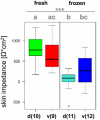Adaption of a dermal in vitro method to investigate the uptake of chemicals across amphibian skin
- PMID: 27752445
- PMCID: PMC5044961
- DOI: 10.1186/s12302-016-0080-y
Adaption of a dermal in vitro method to investigate the uptake of chemicals across amphibian skin
Abstract
Background: Literature data indicate that terrestrial life stages of amphibians may be more sensitive to xenobiotics than birds or mammals. It is hypothesized that dermal exposure could potentially be a significant route of exposure for amphibians, as there is evidence that their skin is more permeable than the skin of other vertebrate species. Thus, higher amounts of xenobiotics might enter systemic circulation by dermal uptake resulting in adverse effects. Heretofore, no guidelines exist to investigate dermal toxicity of chemicals to amphibians. In order to minimize vertebrate testing, this work was targeted to develop an in vitro test system as a possible model to assess the dermal uptake of chemicals across amphibian skin.
Results: The dermal absorption in vitro method (OECD guideline 428), an established toxicological (mammal) test procedure, was adapted to amphibian skin, in a first approach using the laboratory model organism Xenopus laevis and reference compounds (caffeine and testosterone). Skin permeability to both reference substances was significantly higher compared to published mammalian data. Caffeine permeated faster across the skin than testosterone, with ventral skin tending to be more permeable than dorsal skin. As usage of frozen mammalian skin is accepted, frozen skin of X. laevis was tested in parallel. To the freshly excised skin, however, freezing led to increased skin permeability, in particular to caffeine, indicating a loss of skin integrity due to freezing (without additional preservation measures).
Conclusions: This work has demonstrated that the chosen method can be applied successfully to amphibian skin, providing the basis for further investigations. In future, well-established in vitro test systems and a broad dataset for many chemicals may help assess potential amphibian risk from xenobiotics without the need for extensive vertebrate testing.
Keywords: Amphibians; Dermal absorption; In vitro method; Skin permeability; Xenopus laevis.
Figures



Similar articles
-
Acute oral toxicity of chemicals in terrestrial life stages of amphibians: Comparisons to birds and mammals.Regul Toxicol Pharmacol. 2016 Oct;80:335-41. doi: 10.1016/j.yrtph.2016.05.004. Epub 2016 May 10. Regul Toxicol Pharmacol. 2016. PMID: 27177821
-
Amphibians at risk? Susceptibility of terrestrial amphibian life stages to pesticides.Environ Toxicol Chem. 2011 Nov;30(11):2465-72. doi: 10.1002/etc.650. Epub 2011 Sep 20. Environ Toxicol Chem. 2011. PMID: 21898550 Review.
-
Mechanistic modelling of amphibian body burdens after dermal uptake of pesticides from soil.Environ Pollut. 2024 Apr 1;346:123614. doi: 10.1016/j.envpol.2024.123614. Epub 2024 Feb 20. Environ Pollut. 2024. PMID: 38387548
-
Estimating terrestrial amphibian pesticide body burden through dermal exposure.Environ Pollut. 2014 Oct;193:262-268. doi: 10.1016/j.envpol.2014.07.003. Epub 2014 Jul 24. Environ Pollut. 2014. PMID: 25063914
-
Safety and nutritional assessment of GM plants and derived food and feed: the role of animal feeding trials.Food Chem Toxicol. 2008 Mar;46 Suppl 1:S2-70. doi: 10.1016/j.fct.2008.02.008. Epub 2008 Feb 13. Food Chem Toxicol. 2008. PMID: 18328408 Review.
Cited by
-
Scientific Opinion on the state of the science on pesticide risk assessment for amphibians and reptiles.EFSA J. 2018 Feb 23;16(2):e05125. doi: 10.2903/j.efsa.2018.5125. eCollection 2018 Feb. EFSA J. 2018. PMID: 32625798 Free PMC article.
-
Permeability of frog skin to chemicals: effect of penetration enhancers.Heliyon. 2019 Aug 16;5(8):e02127. doi: 10.1016/j.heliyon.2019.e02127. eCollection 2019 Aug. Heliyon. 2019. PMID: 31463380 Free PMC article.
-
Effect of sublethal concentrations of glyphosate-based herbicides (Roundup Active®) on skin of the tropical frog (Dendropsophus molitor).Environ Sci Pollut Res Int. 2023 Oct;30(50):109618-109626. doi: 10.1007/s11356-023-29816-8. Epub 2023 Sep 30. Environ Sci Pollut Res Int. 2023. PMID: 37775634 Free PMC article.
-
Avoidance behavior of juvenile common toads (Bufo bufo) in response to surface contamination by different pesticides.PLoS One. 2020 Nov 30;15(11):e0242720. doi: 10.1371/journal.pone.0242720. eCollection 2020. PLoS One. 2020. PMID: 33253276 Free PMC article.
-
Can models of percutaneous absorption based on in vitro data in frogs predict in vivo absorption?PLoS One. 2020 Jul 29;15(7):e0235737. doi: 10.1371/journal.pone.0235737. eCollection 2020. PLoS One. 2020. PMID: 32726322 Free PMC article.
References
-
- IUCN 2013. The IUCN red list of threatened species. Version 2013–2. http://www.iucnredlist.org. Accessed 9 Oct 2014
-
- Temple HJ, Cox NA. European Red List of Amphibians. Luxemburg: Office for official publications of the European communities; 2009.
-
- Berger G, Schonbrodt T, Langer C, Kretschmer H. Die Agrarlandschaft der Lebusplatte als Lebensraum für Amphibien. Rana Sonderheft. 1999;3:81–99.
LinkOut - more resources
Full Text Sources
Other Literature Sources
Research Materials
